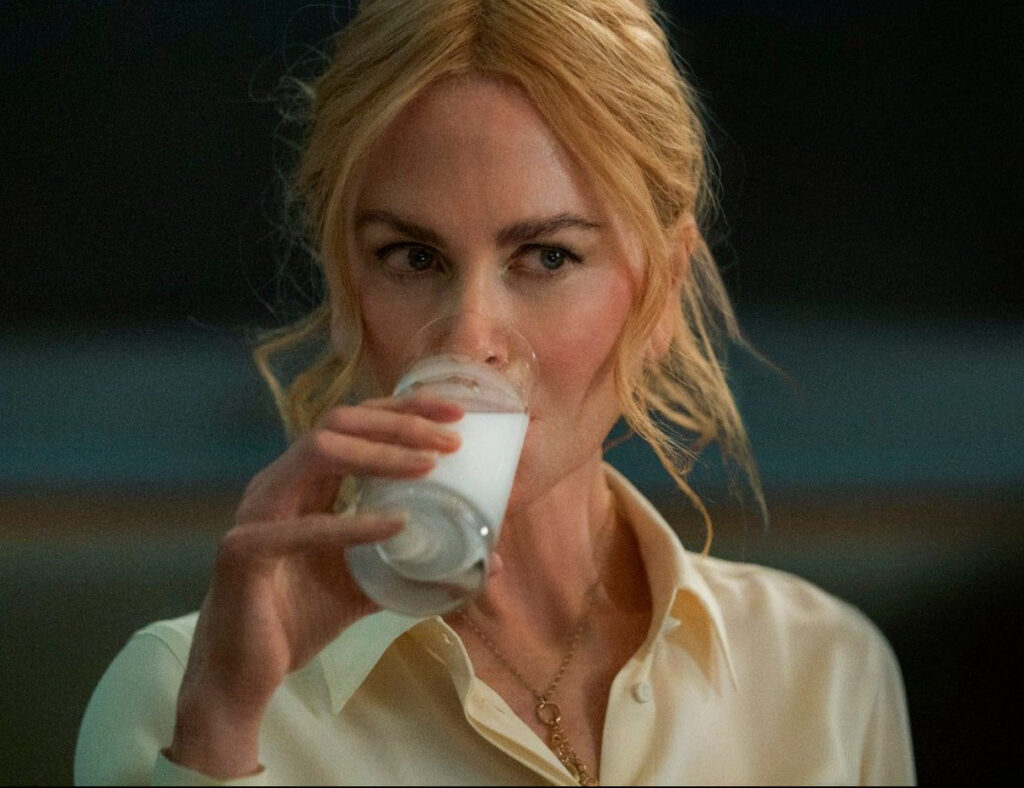The intersection of life and art is often a fascinating one, where reality can inspire some of the most evocative moments in film. Such is the case for the controversial yet striking milk scene in Babygirl, where a young woman receives an unsolicited glass of milk from a man at a bar. Recently, the director of Babygirl revealed that this particular scene was not only inspired by real life but was an actual event in her own experience. In this detailed recounting, the director shares the unnerving dynamics of the interaction, the cultural undercurrents it represents, and how such moments shape art and challenge audiences.
A Glass of Milk and a Staring Contest: The Real-Life Scene
The Babygirl director explained during a recent interview that the now-infamous milk scene—widely discussed for its absurdity and unsettling undertones—was drawn directly from her life. As she recounted, she was sitting alone at a bar when a “famous Belgian actor” at least 15 years her junior sent over a glass of milk.
“I remember thinking it was so surreal,” she said. “Of all the things to send a woman at a bar, he chose milk. It wasn’t champagne, not even a cocktail—just plain milk. And what was stranger was how he sat there, watching me, gauging my reaction.”
The director acknowledged that the gesture might seem humorous on the surface, but it also carried a deeper, disconcerting power play. By sending something so unconventional, the actor disrupted the usual codes of behavior, creating an unsettling moment that was difficult to ignore.
The Symbolism of Milk
Milk is a loaded symbol—one that evokes images of purity, nurturing, and even infantilization. In the context of a bar, where alcohol is the norm, sending milk introduces an almost jarring dynamic. It is a deliberate departure from the typical gestures of flirtation, challenging the recipient’s response.
“It felt like a statement, like he was saying, ‘You’re not like the others here,’” the director explained. “There was a layer of condescension to it, as though he assumed some level of authority over how I should be seen and treated. And yet, I couldn’t stop myself from drinking it—it was absurd and oddly compelling.”
The act of drinking the milk became a pivotal moment of self-awareness for the director, one that she later imbued into the character in Babygirl. This interplay of curiosity, defiance, and submission was the emotional crux of the scene, leaving audiences unsettled and intrigued.
Power, Gender, and Subversion
The milk scene in Babygirl speaks to broader themes of power, gender dynamics, and the subversion of norms. On one level, it serves as a commentary on how women are often subjected to unwanted attention or gestures that test their boundaries. The milk, in this case, becomes a tool of disruption—a way to provoke a reaction and assert control.
In the real-life interaction, the director felt the weight of these dynamics. She described how the Belgian actor’s youth added a layer of complexity to the situation. “He was at least 15 years younger, which flipped the usual script of older men hitting on younger women. But his fame and confidence gave him a kind of untouchable quality, as though he could get away with anything. And in that moment, he did.”
This complexity mirrors the layered storytelling in Babygirl, where seemingly mundane actions carry profound emotional and psychological weight.
From Personal Experience to Artistic Interpretation
Transforming this real-life moment into art required a delicate balance of honesty and creative reinterpretation. The director wanted to capture the emotional truth of the encounter without reducing it to mere spectacle. In Babygirl, the milk scene unfolds with a mix of tension, humor, and vulnerability, drawing viewers into the protagonist’s inner world.
“What I loved about the scene was how it made people uncomfortable,” the director said. “It’s not about the milk itself—it’s about the power dynamics and the unspoken tension that comes with such a gesture. It’s a test, a dare, and an invitation all at once.”
Audience Reactions and Cultural Context
The milk scene has sparked diverse reactions from audiences and critics alike. Some have praised its originality and emotional depth, while others have questioned its plausibility and purpose. The revelation that the scene was based on a true story adds a new layer of intrigue, challenging viewers to reconsider their interpretations.
In many ways, the scene reflects a cultural moment where traditional power structures are being questioned and redefined. The act of sending milk—a symbol of innocence—takes on a provocative edge in a world where gestures of dominance are often disguised as benign or playful acts.
The Role of Absurdity in Storytelling
Absurdity is a powerful tool in storytelling, allowing filmmakers to highlight the strangeness of everyday life. The milk scene in Babygirl uses absurdity to draw attention to deeper truths about human behavior and social norms. By defying expectations, the scene forces audiences to confront their own assumptions and biases.
The director sees this use of absurdity as a reflection of her own worldview. “Life is strange and unpredictable,” she said. “The milk was such a bizarre moment, but it stuck with me because it felt so real. It reminded me that the most memorable stories often come from the unexpected.”
The real-life milk scene that inspired Babygirl is a testament to the power of personal experience in shaping art. By drawing on her own encounter, the director created a moment that resonates with audiences on multiple levels, sparking conversations about gender, power, and the role of absurdity in storytelling.
Ultimately, the milk scene is more than just a quirky anecdote—it is a profound exploration of the ways in which small, seemingly insignificant actions can carry deep emotional and symbolic weight. As the director herself said, “It’s in the strange, uncomfortable moments that we find the most truth.”
No comments yet.







